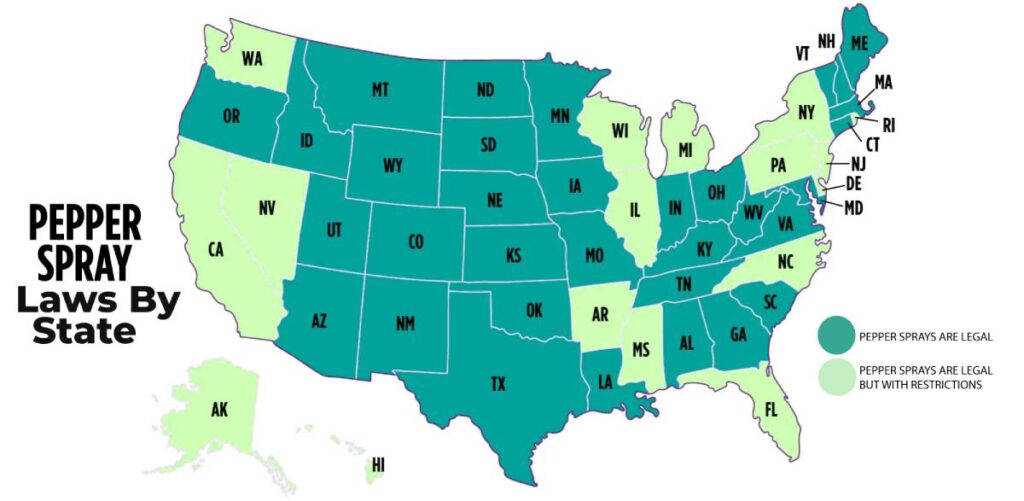Table of Contents
- Understanding South Carolina’s Carrying Spray Volume Regulations
- Key Factors Influencing Spray Volume Limits in South Carolina
- Practical Implications for Agricultural and Commercial Applications
- Expert Recommendations for Compliance and Best Practices
- To Conclude
Understanding South Carolina’s Carrying Spray Volume Regulations
South Carolina has specific laws regulating the volume of spray that individuals are allowed to carry on their person or in their vehicles, primarily aimed at ensuring public safety and environmental protection. These regulations typically apply to substances like pepper spray or other self-defense aerosols and are designed to prevent misuse or excessive possession that could raise safety concerns. Understanding these limits is crucial for residents and visitors who rely on carrying spray devices for personal protection, as exceeding the allowed quantity can lead to fines or legal complications.
Key points to keep in mind include:
- Maximum Carrying Volume: South Carolina generally caps the allowable spray volume, often around 2 ounces, but always verify the exact legal limits before purchasing or carrying.
- Age Restrictions: Certain age requirements must be met to legally carry these sprays, frequently limiting sales to those 18 and older.
- Use and Possession Locations: Some areas, such as government buildings or schools, may prohibit carrying any spray devices regardless of volume.
- Proper Labeling and Packaging: Sprays should have clear labeling indicating their content and volume for legal compliance.
Adhering to South Carolina’s spray volume laws ensures you stay within legal boundaries while maintaining your right to self-defense tools. It’s advisable to regularly check for any legislative updates that may affect these regulations.
Key Factors Influencing Spray Volume Limits in South Carolina
Several essential elements come into play when determining the maximum spray volume allowed in South Carolina. The state’s unique climate, combined with its diverse agricultural and urban areas, necessitates careful consideration of environmental impact and effectiveness. Regulatory agencies pay close attention to weather conditions such as wind speed and direction to minimize drift and ensure safe application. Additionally, the types of chemicals being used, including their toxicity and potential runoff hazards, dictate strict volume limits to protect water sources and non-target species.
Moreover, the nature of the target pest or vegetation influences permitted spray volumes, with some crops requiring lighter applications and others needing more intensive treatment. The soil type and topography also contribute, as they affect absorption and runoff rates. In practice, applicators must adhere to these factors to avoid violations and promote sustainable spraying practices. Key considerations include:
- Local weather and environmental conditions
- Chemical toxicity and recommended dosages
- Target species and vegetation density
- Soil composition and landscape features
- State regulatory frameworks and safety guidelines
Practical Implications for Agricultural and Commercial Applications
Understanding the carrying spray volume limit is crucial for optimizing both agricultural productivity and commercial spraying operations in South Carolina. For farmers, adhering to these limits ensures compliance with state regulations while minimizing chemical waste and environmental impact. Applying the correct spray volume enhances the effectiveness of pesticides and fertilizers, leading to better crop health and yield. Commercial applicators benefit from precise volume control as it promotes safer application practices, reduces drift, and improves customer satisfaction by delivering consistent, targeted treatment.
Implementing these guidelines also supports sustainable farming and commercial landscaping by promoting resource efficiency. Key practical advantages include:
- Cost savings: Using the specified spray volume reduces unnecessary chemical use, cutting expenses without compromising results.
- Environmental protection: Controlled spraying limits runoff and contamination, contributing to cleaner water sources and healthier ecosystems.
- Regulatory compliance: Following volume limits helps avoid fines or penalties, safeguarding your operation’s reputation and longevity.
- Improved application accuracy: Meeting prescribed volumes ensures even coverage, maximizing pesticide or nutrient effectiveness.
Expert Recommendations for Compliance and Best Practices
To navigate South Carolina’s regulations surrounding spray volume limits effectively, it’s crucial to prioritize both legal compliance and best practices that ensure your safety and the safety of others. Experts consistently emphasize the importance of thoroughly understanding the specific limits set by state law-knowing your exact permissible volume is the foundation of responsible carrying. Additionally, it’s highly recommended to maintain accurate documentation of your equipment and spray volumes, which can be invaluable if you ever need to demonstrate adherence to the rules during a law enforcement encounter.
Beyond legal adherence, seasoned professionals advocate for adopting certain best practices that can elevate your preparedness and minimize risk. These include:
- Regularly verifying spray container size to ensure compliance is not inadvertently breached.
- Choosing compact, reliable spray devices designed to deliver effective control without exceeding volume limits.
- Storing and carrying sprays securely to prevent accidental discharge or damage.
- Updating yourself frequently on any changes in state regulations, as legal parameters may evolve.
By integrating these recommendations into your daily routine, you foster a safer carrying environment and demonstrate a proactive commitment to responsible use.
To Conclude
In summary, understanding South Carolina’s carrying spray volume limit is essential for ensuring compliance and making informed decisions, whether you’re a commercial applicator or a private user. By staying informed about the specific volume restrictions and regulations, you can help protect both the environment and public health while effectively managing pest control. Keep this guide handy as a reference, and don’t hesitate to consult local authorities or extension services if you have further questions. Staying empowered with knowledge is the best way to navigate South Carolina’s spray volume rules confidently and responsibly.Check Our Other Blogs
- StunGun – Your Trusted Source for Stun Guns, Laws, and Self-Defense Tips
- PepperSprayLaws – Your Trusted Resource for Pepper Spray Information
- StunGunLaws – Your Trusted Guide to Stun Gun Legality and Safety




